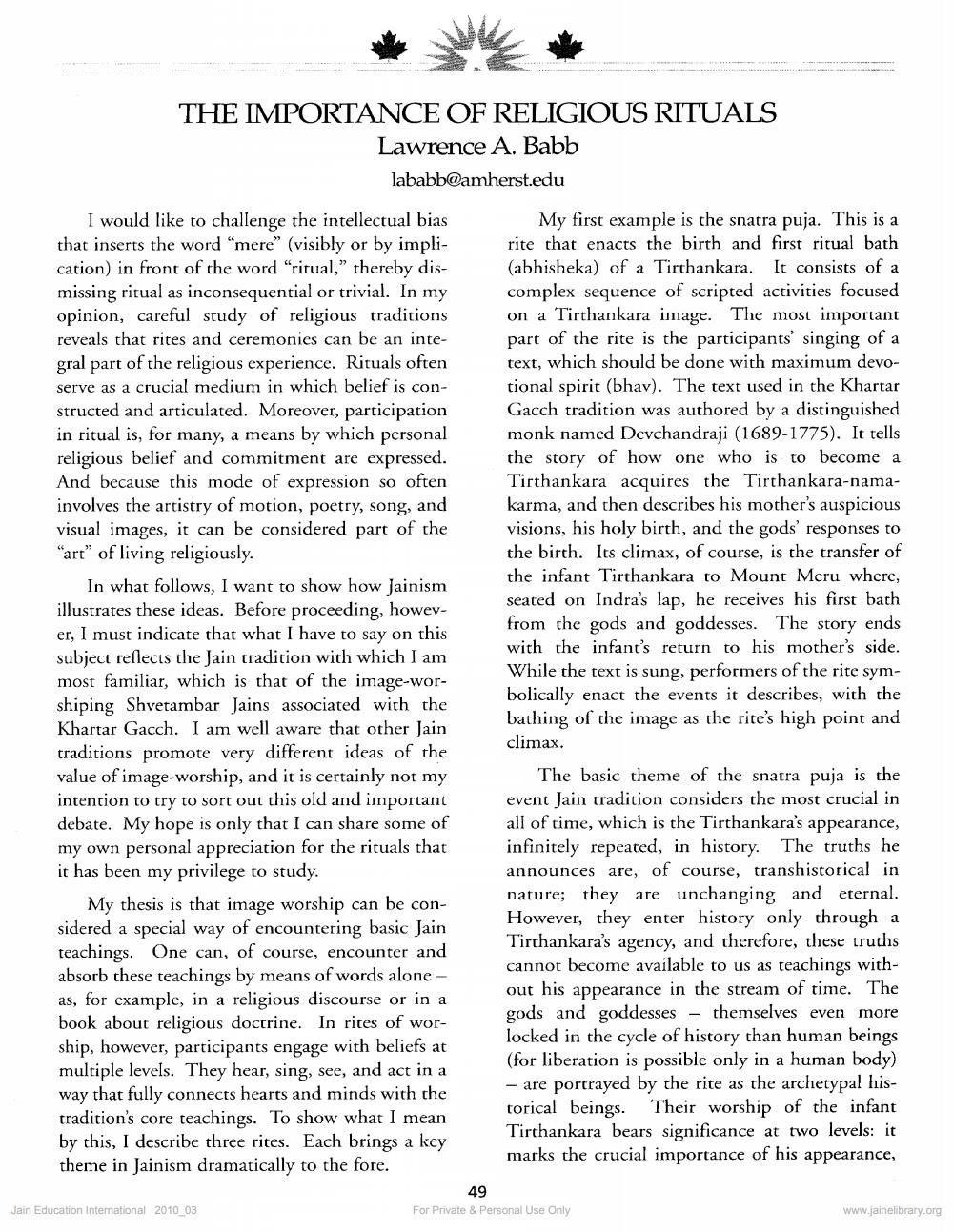________________
THE IMPORTANCE OF RELIGIOUS RITUALS
Lawrence A. Babb
[email protected] I would like to challenge the intellectual bias My first example is the snatra puja. This is a that inserts the word "mere" (visibly or by impli- rite that enacts the birth and first ritual bath cation) in front of the word "ritual," thereby dis- (abhisheka) of a Tirthankara. It consists of a missing ritual as inconsequential or trivial. In my complex sequence of scripted activities focused opinion, careful study of religious traditions on a Tirthankara image. The most important reveals that rites and ceremonies can be an inte- part of the rite is the participants' singing of a gral part of the religious experience. Rituals often text, which should be done with maximum devoserve as a crucial medium in which belief is con- tional spirit (bhav). The text used in the Khartar structed and articulated. Moreover, participation Gacch tradition was authored by a distinguished in ritual is, for many, a means by which personal monk named Devchandraji (1689-1775). It tells religious belief and commitment are expressed. the story of how one who is to become a And because this mode of expression so often Tirthankara acquires the Tirthankara-namainvolves the artistry of motion, poetry, song, and karma, and then describes his mother's auspicious visual images, it can be considered part of the visions, his holy birth, and the gods' responses to "art" of living religiously.
the birth. Its climax, of course, is the transfer of In what follows, I want to show how Jainism
the infant Tirthankara to Mount Meru where, illustrates these ideas. Before proceeding, howev
seated on Indra's lap, he receives his first bath er, I must indicate that what I have to say on this
from the gods and goddesses. The story ends
with the infant's return to his mother's side. subject reflects the Jain tradition with which I am
While the text is sung, performers of the rite symmost familiar, which is that of the image-wor
bolically enact the events it describes, with the shiping Shvetambar Jains associated with the Khartar Gacch. I am well aware that other Jain
bathing of the image as the rite's high point and
climax. traditions promote very different ideas of the value of image-worship, and it is certainly not my
The basic theme of the snatra puja is the intention to try to sort out this old and important event Jain tradition considers the most crucial in debate. My hope is only that I can share some of all of time, which is the Tirthankara's appearance, my own personal appreciation for the rituals that infinitely repeated, in history. The truths he it has been my privilege to study.
announces are, of course, transhistorical in My thesis is that image worship can be con
nature; they are unchanging and eternal.
However, they enter history only through a sidered a special way of encountering basic Jain teachings. One can, of course, encounter and
Tirthankara's agency, and therefore, these truths absorb these teachings by means of words alone -
cannot become available to us as teachings withas, for example, in a religious discourse or in a
out his appearance in the stream of time. The book about religious doctrine. In rites of wor
gods and goddesses – themselves even more
locked in the cycle of history than human beings ship, however, participants engage with beliefs at multiple levels. They hear, sing, see, and act in a
(for liberation is possible only in a human body) way that fully connects hearts and minds with the
- are portrayed by the rite as the archetypal histradition's core teachings. To show what I mean
torical beings. Their worship of the infant by this, I describe three rites. Each brings a key
Tirthankara bears significance at two levels: it
marks the crucial importance of his appearance, theme in Jainism dramatically to the fore.
49
Jain Education Interational 2010_03
For Private & Personal Use Only
www.jainelibrary.org




